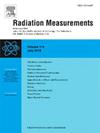Development of a phoswich detector for low-energy gamma rays emitted from alpha emitters
IF 2.2
3区 物理与天体物理
Q2 NUCLEAR SCIENCE & TECHNOLOGY
引用次数: 0
Abstract
The decommissioning of the Fukushima Daiichi Nuclear Power Station requires thorough inspection of piping for contamination, including alpha nuclides. Since external alpha particle measurements are impractical, detection relies on gamma-rays emitted by the alpha nuclides. Therefore, a phoswich detector for detecting low-energy gamma-rays was developed and experimentally validated. The detector was designed with consideration of energy deposition characteristics and consists of YAP:Ce or High Energy Resolution Gd3(Ga,Al)5O12(Ce) (HR-GAGG) scintillators in combination with BGO scintillators, employing a photomultiplier tube for signal amplification. Validation procedures included Monte Carlo simulations and measurements using actual radiation sources. Both measurement and simulation results demonstrate a correlation in scintillator energy depositions across different gamma-ray energies. Pulse Shape Discrimination (PSD) plots effectively differentiate between low-energy and high-energy gamma-rays, thereby confirming the predictions from simulations. The combination of YAP:Ce and BGO with a digitizer enables detection of low energy gamma-rays and high energy gamma-rays. With the 0.5 mm thick YAP:Ce scintillator, the energy resolution was 29.1 % FWHM at 59.5 keV. Figure of Merit (FOM) was evaluated as 1.97. The detection efficiency for 60 keV gamma-rays was about 14 %. These results suggest promising potential for developing a sensitive low-energy gamma-ray detector utilizing various scintillator combinations. The phoswich detector shows promise for effectively detecting low-energy gamma-rays emitted by alpha nuclides in piping.
一种用于从α发射器发射的低能伽马射线的光电探测器的研制
福岛第一核电站(Fukushima Daiichi Nuclear Power Station)的退役需要对管道进行彻底的污染检查,包括α核素。由于外部α粒子的测量是不切实际的,探测依赖于α核素发射的伽马射线。为此,研制了一种用于探测低能伽马射线的光电探测器,并进行了实验验证。该探测器的设计考虑了能量沉积特性,由YAP:Ce或高能量分辨率Gd3(Ga,Al) 5012 (Ce) (HR-GAGG)闪烁体与BGO闪烁体结合组成,采用光电倍增管进行信号放大。验证程序包括蒙特卡罗模拟和使用实际辐射源的测量。测量和模拟结果都证明了闪烁体能量沉积在不同伽马射线能量之间的相关性。脉冲形状判别(PSD)图有效地区分了低能和高能伽马射线,从而证实了模拟的预测。YAP:Ce和BGO与数字化仪的结合可以检测低能伽马射线和高能伽马射线。在59.5 keV下,0.5 mm厚的YAP:Ce闪烁体的能量分辨率为29.1% FWHM。优点指数(FOM)为1.97。对60 keV伽马射线的探测效率约为14%。这些结果表明,利用各种闪烁体组合开发灵敏的低能伽马射线探测器具有很大的潜力。该光子探测器有望有效探测管道中α核素发出的低能伽马射线。
本文章由计算机程序翻译,如有差异,请以英文原文为准。
求助全文
约1分钟内获得全文
求助全文
来源期刊

Radiation Measurements
工程技术-核科学技术
CiteScore
4.10
自引率
20.00%
发文量
116
审稿时长
48 days
期刊介绍:
The journal seeks to publish papers that present advances in the following areas: spontaneous and stimulated luminescence (including scintillating materials, thermoluminescence, and optically stimulated luminescence); electron spin resonance of natural and synthetic materials; the physics, design and performance of radiation measurements (including computational modelling such as electronic transport simulations); the novel basic aspects of radiation measurement in medical physics. Studies of energy-transfer phenomena, track physics and microdosimetry are also of interest to the journal.
Applications relevant to the journal, particularly where they present novel detection techniques, novel analytical approaches or novel materials, include: personal dosimetry (including dosimetric quantities, active/electronic and passive monitoring techniques for photon, neutron and charged-particle exposures); environmental dosimetry (including methodological advances and predictive models related to radon, but generally excluding local survey results of radon where the main aim is to establish the radiation risk to populations); cosmic and high-energy radiation measurements (including dosimetry, space radiation effects, and single event upsets); dosimetry-based archaeological and Quaternary dating; dosimetry-based approaches to thermochronometry; accident and retrospective dosimetry (including activation detectors), and dosimetry and measurements related to medical applications.
 求助内容:
求助内容: 应助结果提醒方式:
应助结果提醒方式:


